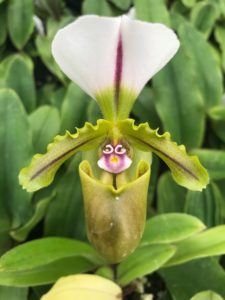Paphiopedilum spicerianum is a species that is native to India, Burma and Southern China. It was introduced to the hobby in the late 1800’s and has always been very popular among Paph growers. You may have one in your collection, or at least you may think you do.
Unfortunately, many of the Paphiopedilum spicerianum offered for sale today are actually hybrids. Oh, they cleverly disguise themselves as the species, but they are imposters. They can even fool taxonomists.
The History of Paphiopedilum spicerianum
How did this happen? About 20 years ago, Alan Koch, at Gold Country Orchids, was offered a division of Paphiopedilum spicerianum ‘Marshall’s’ AM/AOS. He purchased the division, but the plant wasn’t quite ready to divide, so he was sent some pollen in the meantime. He put the pollen on his clone of ‘St. Albans’ HCC/AOS and set a pod. His order for 5 flasks was misinterpreted by the lab and he was sent 50. As he had no use for that many plants, he gave flasks to many Paph growers around the country. Some growers who received them sent some of the flasks to growers in Taiwan. Basically, they ended up everywhere!
 The next year Alan finally received his division of ‘Marshall’s’. When he saw the flower in person, he realized that it was not actually Paphiopedilum spicerianum but a hybrid. He immediately let everyone who had received flasks know about the mistake, but these plants grew like weeds. Hybrid vigor will do this! Many had already made their way into the market, and many more followed as some vendors didn’t really care. After all, they look like spicerianum.
The next year Alan finally received his division of ‘Marshall’s’. When he saw the flower in person, he realized that it was not actually Paphiopedilum spicerianum but a hybrid. He immediately let everyone who had received flasks know about the mistake, but these plants grew like weeds. Hybrid vigor will do this! Many had already made their way into the market, and many more followed as some vendors didn’t really care. After all, they look like spicerianum.
In the years that followed these vigorous doppelgangers were used by unsuspecting breeders to flood the market with hybrid spicerianum. Some are recognizable, most are not. Those with flat dorsal sepals are likely hybrids. If you are able to see a group of siblings in bloom you may see some that lack the distinctive yellow-green cross on the staminodal shield. Some may also have poorly formed curls at the top of the staminode. Only a taxonomist can tell for sure. Even then you can only really be sure if you see a group of siblings and determine if there is variation among them.
What’s this mean to you?
So how can you avoid buying a hybrid? Knowing the providence of the seedlings can help. Those made with old clones from before 2000 are safe bets. Also buying from a breeder who has maintained their breeding lines without adding ‘tainted’ stock. For many folks, it may not be that much of a big deal, but for a real ‘Paph purist’ it definitely does! We have the ‘real deal’ available here.
